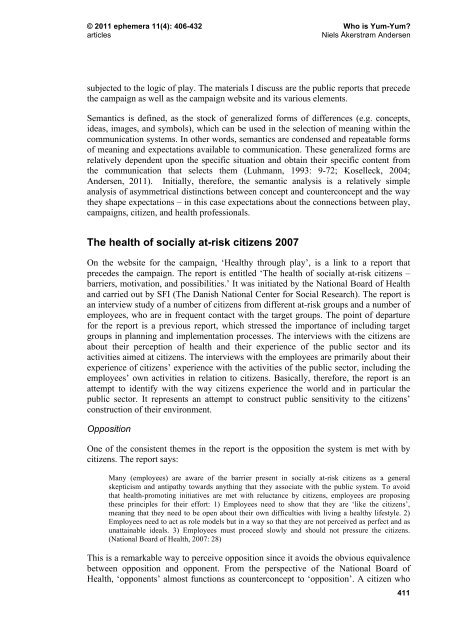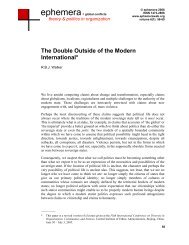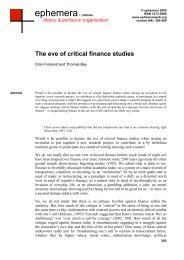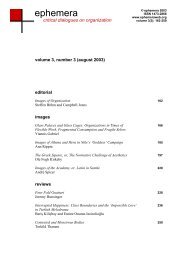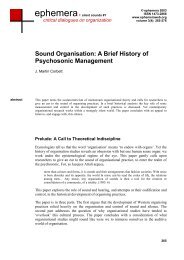Work, play and boredom - Ephemera
Work, play and boredom - Ephemera
Work, play and boredom - Ephemera
You also want an ePaper? Increase the reach of your titles
YUMPU automatically turns print PDFs into web optimized ePapers that Google loves.
© 2011 ephemera 11(4): 406-432 Who is Yum-Yum?<br />
articles Niels Åkerstrøm Andersen<br />
subjected to the logic of <strong>play</strong>. The materials I discuss are the public reports that precede<br />
the campaign as well as the campaign website <strong>and</strong> its various elements.<br />
Semantics is defined, as the stock of generalized forms of differences (e.g. concepts,<br />
ideas, images, <strong>and</strong> symbols), which can be used in the selection of meaning within the<br />
communication systems. In other words, semantics are condensed <strong>and</strong> repeatable forms<br />
of meaning <strong>and</strong> expectations available to communication. These generalized forms are<br />
relatively dependent upon the specific situation <strong>and</strong> obtain their specific content from<br />
the communication that selects them (Luhmann, 1993: 9-72; Koselleck, 2004;<br />
Andersen, 2011). Initially, therefore, the semantic analysis is a relatively simple<br />
analysis of asymmetrical distinctions between concept <strong>and</strong> counterconcept <strong>and</strong> the way<br />
they shape expectations – in this case expectations about the connections between <strong>play</strong>,<br />
campaigns, citizen, <strong>and</strong> health professionals.<br />
The health of socially at-risk citizens 2007<br />
On the website for the campaign, ‘Healthy through <strong>play</strong>’, is a link to a report that<br />
precedes the campaign. The report is entitled ‘The health of socially at-risk citizens –<br />
barriers, motivation, <strong>and</strong> possibilities.’ It was initiated by the National Board of Health<br />
<strong>and</strong> carried out by SFI (The Danish National Center for Social Research). The report is<br />
an interview study of a number of citizens from different at-risk groups <strong>and</strong> a number of<br />
employees, who are in frequent contact with the target groups. The point of departure<br />
for the report is a previous report, which stressed the importance of including target<br />
groups in planning <strong>and</strong> implementation processes. The interviews with the citizens are<br />
about their perception of health <strong>and</strong> their experience of the public sector <strong>and</strong> its<br />
activities aimed at citizens. The interviews with the employees are primarily about their<br />
experience of citizens’ experience with the activities of the public sector, including the<br />
employees’ own activities in relation to citizens. Basically, therefore, the report is an<br />
attempt to identify with the way citizens experience the world <strong>and</strong> in particular the<br />
public sector. It represents an attempt to construct public sensitivity to the citizens’<br />
construction of their environment.<br />
Opposition<br />
One of the consistent themes in the report is the opposition the system is met with by<br />
citizens. The report says:<br />
Many (employees) are aware of the barrier present in socially at-risk citizens as a general<br />
skepticism <strong>and</strong> antipathy towards anything that they associate with the public system. To avoid<br />
that health-promoting initiatives are met with reluctance by citizens, employees are proposing<br />
these principles for their effort: 1) Employees need to show that they are ‘like the citizens’,<br />
meaning that they need to be open about their own difficulties with living a healthy lifestyle. 2)<br />
Employees need to act as role models but in a way so that they are not perceived as perfect <strong>and</strong> as<br />
unattainable ideals. 3) Employees must proceed slowly <strong>and</strong> should not pressure the citizens.<br />
(National Board of Health, 2007: 28)<br />
This is a remarkable way to perceive opposition since it avoids the obvious equivalence<br />
between opposition <strong>and</strong> opponent. From the perspective of the National Board of<br />
Health, ‘opponents’ almost functions as counterconcept to ‘opposition’. A citizen who<br />
411


